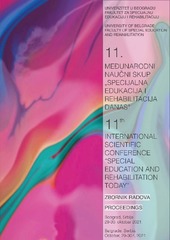Prikaz osnovnih podataka o dokumentu
Mapping hand function in rare neurodevelopmental disorders
| dc.creator | Berencsi, Andrea | |
| dc.creator | Botló, Enikő | |
| dc.creator | Fáczán, Dóra | |
| dc.creator | Kovács, Ilona | |
| dc.creator | Vámos, Tibor | |
| dc.date.accessioned | 2021-11-02T13:54:53Z | |
| dc.date.available | 2021-11-02T13:54:53Z | |
| dc.date.issued | 2021 | |
| dc.identifier.isbn | 978-86-6203-150-1 | |
| dc.identifier.uri | http://rfasper.fasper.bg.ac.rs/handle/123456789/3758 | |
| dc.description.abstract | Introduction: Appropriate level of hand function is a key to participation in daily living activities, education and social life. Mapping functional abilities related to hand may be challenging but important for ensuring participation in rare neurodevelopmental disorders. We previously showed specific patterns of motor control and learning capacity of the hand in Williams syndrome, a genetically originated neurodevelopmental disorder that involves intellectual disability and motor deficits. Aim: Our aim in the present study was to further map the functional motor skills related to daily living activities and possible sensory dysfunction related to the hand in this rare neurodevelopmental disorder. Method: Participation in activities related to hand function was assessed by the Jebsen-Taylor Hand Function Test. Maximum motor speed in terms of index finger tapping and somatosensory function in terms of two-point discrimination and position sense were assessed. Results and conclusion: Descriptive data analysis revealed that participation in the daily living activities shows difficulties for individuals with Williams syndrome in all domains. Moreover, somatosensory deficits and limitations in motor speed may accompany functional challenges. We also found that the Jebsen-Taylor Hand Function Test was appropriate to use and is a promising tool for daily living activity assessment in the case of mild and moderate intellectual disability with the exception of the “writing” subtest. Regarding somatosensory testing, two-point discrimination test was not applicable for all participants position sense. Our results support the need for further establishment of the relationship between neurophysiological, sensory and motor functional characteristics related to hand. | sr |
| dc.language.iso | en | sr |
| dc.publisher | Univerzitet u Beogradu – Fakultet za specijalnu edukaciju i rehabilitaciju/ University of Belgrade – Faculty of Special Education and Rehabilitation | sr |
| dc.rights | openAccess | sr |
| dc.rights.uri | https://creativecommons.org/licenses/by-sa/4.0/ | |
| dc.source | Zbornik radova - 11. Međunarodni naučni skup „Specijalna edukacija i rehabilitacija danas“, Beograd, Srbija, 29–30.10.2021. | sr |
| dc.subject | fine motor function | sr |
| dc.subject | hand | sr |
| dc.subject | somatosensory | sr |
| dc.subject | Williams syndrome | sr |
| dc.subject | rare disease | sr |
| dc.title | Mapping hand function in rare neurodevelopmental disorders | sr |
| dc.type | conferenceObject | sr |
| dc.rights.license | BY-SA | sr |
| dc.citation.epage | 43 | |
| dc.citation.spage | 37 | |
| dc.identifier.fulltext | http://rfasper.fasper.bg.ac.rs/bitstream/id/4229/bitstream_4229.pdf | |
| dc.identifier.rcub | https://hdl.handle.net/21.15107/rcub_rfasper_3758 | |
| dc.type.version | publishedVersion | sr |


